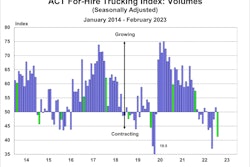
Mud flaps are something fleets probably don’t pay a lot of attention to, especially when it comes to fuel economy, and tend to focus on bigger things like tractor and trailer aerodynamic devices and low rolling resistance tires. But the reality is that the right mud flap — an aerodynamic one — can save fuel and improve maintenance.
One caveat: there is a big difference between good aerodynamic mud flaps and bad ones and every fleet needs to understand the differences because choosing the wrong one has negative consequences.
First, a little background
I remember being in a meeting with Mesilla Valley Transportation (MVT) CEO Royal Jones. When presented with an aerodynamic mud flap, Royal said, “We’re not running those fly swatters on our equipment.”
The next week, MVT Solutions ran three track tests on a set of aerodynamic mud flaps and we found that they did, in fact, save fuel. For the MVT fleet that equated to an annual savings of $275,000. If you know Royal, you can guess his response: “It looks like we’re in the fly swatter business.”
Three months later the entire fleet was retrofitted with them and they have been spec’d on new vehicles ever since. And Mesilla Valley Transportation (CCJ Top 250, No. 68) is not the only fleet to see the benefit of switching to aerodynamic mud flaps.
In fact, aerodynamic mud flaps are often the first choice a fleet makes when looking to improve MPGs because of the small capital investment and quick return on investment. However, fuel savings will vary.
For MVT's sleek dry van equipment, savings were less than 1 gallon per 1,000 miles; let’s call is 1%. This is a small number and it's one of the reasons the benefits have been difficult to quantify. While testing with other fleets, we’ve seen higher savings simply based on vehicle configuration.
The more the mud flap is in the air stream, the more savings that are possible. On 28-foot double trailers we’ve seen savings of 4 to 5 gallons per 1,000 miles. Let me put that in perspective for you: When traveling 100,000 miles annually, and with diesel at $4 per gallon, that equates to a $1,600 to $2,000 savings per truck. That’s a lot of money for simply choosing the right aerodynamic mud flap.
Aerodynamic mud flaps also have some maintenance benefits. Premium aerodynamic mud flaps are made of either nylon 66 or impact modified polypropylene, which are extremely tough and nearly indestructible. These mud flaps are so durable that some fleets are adopting them for the maintenance benefits alone. Due to their durability, they don’t get torn off when backing into curbs, driving over debris on the highway, and we’ve even seen them stand up to tire blow outs.
Given all these benefits, why aren’t more fleets adopting aerodynamic mud flaps? Unfortunately, some fleets have had bad experiences with poor quality ones, and therefore believe all aerodynamic mud flaps are bad. If an aerodynamic mud flap is not made of the right material, it won't last. It will crack, split and break because the holes act as stress points. Their performance in cold weather is even worse.
A key takeaway when it comes to aerodynamic mud flaps is to make sure you invest in premium high quality versions. Make sure they are made of durable nylon 66 or polypropylene material, and ask the vendor to prove it. Look for mud flaps that have a warranty of at least one year. Ensure the product has fuel economy test results that you can review and trust and ask the vendor for names of fleets that are currently using their products and contact them to find out what their experience has been.
If you do all this, I think you will find that aerodynamic mud flaps are small investment that can result in big savings.













